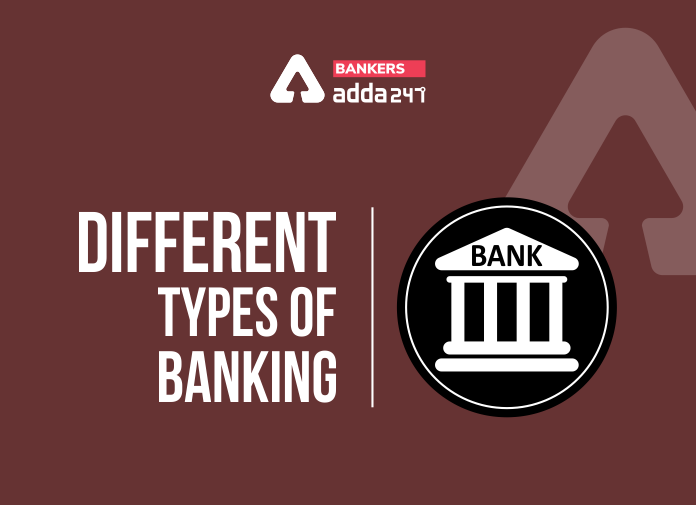Banking Awareness is one of the most important sections and questions are often asked from this section. You must prepare this section as it will also help you to crack your Interview. So make sure you are preparing this section well. In this article, we will be discussing about the banking and its type. This is one of the most commonly asked topic in interview as well as in Mains examination of several banking exam.
Also Read,
| Upcoming Bank Exams 2020 | Government Jobs for Graduates 2020 | Consumer Price Index: Definition, Types, Measurement |
Branch Banking
In this type of banking, It involves the business of banking via branches. A branch all banking services are available and it includes a specialized branch, a satellite office, an extension counter, an ATM, administrative office, service branch and a credit card center for branch authorization policy. The benefit of branch banking is better management, more inclusion and risk diversification.
Unit Banking
In this type of banking, banks are operated from a single branch( or few branches in the area) taking care of the local community. This helps to cater to the banking facility on a smaller level. The best thing about Unit banking that due to its small-size the decision taken in this type of banking is fast. The management is easy and efficient.
Mixed Banking
In Mixed Banking, banks perform both the activities if commercial and investment banking together. The banks performing mixed banking give short-term and long-term loans to industrial concerns. The banks performing these activities requires experts who give valuable advice on various financial issues and also help gauge the financial health of companies. These banks helps to promote rapid industrialization.
Also Read,
| SBI Clerk Mains 2020 Study Plan | SBI PO Prelims Study Plan 2020 | RBI Assistant Mains Exam Study Plan 2020 – Download PDF now |
Chain Banking
In Chain banking, the owners of different banks come together to own and control three or more independently chartered banks. Even though, these banks have common control and ownership still each of these banks could maintain their independent existence. These banks which are part of the chain have different functions to prevent loss of profit and overlapping of interests.
Retail Banking
In Retail Banking, transactions are held directly with customers and there are no transactions with other banks or corporations. The banks involved in retail banking provide all kinds of personal banking services to customers like saving accounts, transactional accounts, mortgages, personal loans, debit and credit cards, etc.
Also Read,
Wholesale Banking
In Wholesale Banking, banks deal in banking services for high net-worth clients like corporate, commercial banks, mid-size companies, etc. These banks provide ease of access to the complete financial portfolio of a client who can easily browse through the same and make suitable allocations, transfers, etc.
Relationship Banking
In Relationship banking, banks make deliberate efforts to understand customer needs and offer him products accordingly. Through this type of banking banks are easily available to do cross-selling of the products. It also helps the banks to gather critical soft information about the borrowers, which helps them to determine the creditworthiness of such clients.
Correspondent Banking
In Correspondent banking, banks do business in foreign countries where they have no physical presence. Banks providing as correspondent banking are known as Correspondent banks and act as banking agent for a home bank and provides various banking services to customers where otherwise the home bank does not operate.
Also Read,
| What is Repo Rate ? | What is PMJDY? | CLR Vs SLR | Coronavirus Count |
Social Banking
In Social banking, banking services are oriented towards mass welfare and financial inclusion of the poor and vulnerable segments of society. We have come across several commendable initiatives taken by RBI to make financial inclusion a reality for the remotest segments of the Indian population. Three-year Inclusion plan for banks, relaxation of KYC documentation are some of the examples of social banking.
Virtual Banking
In Virtual banking, customers have access to all the banking services but online. This type of banking brought a great revolution in the banking industry and has made things easy. In this type of banking, banks are not required to have physical offices and that is why they are very cost-effective and banks thus pass these benefits to customers in the form of waiving of account fee or higher rates of interest.
Also check,
| IBPS PO 2020 Detailed Syllabus for Prelims and Mains | IBPS PO Final Result 2020-Check Final Result Date at @ibps.in |
Narrow Banking
In Narrow Banking, the investment is done in areas where there is no risk or have minimum risk for ex- Government securities, etc. We can say that narrow banking is a complete antonym of Shadow banking.
Islamic Banking
Islamic banking is banking which works on Islamic laws. In this type of banking thee profit is shared with the customers and also no interest is taken on the loan nor it is given on the deposit.
Shadow Banking
In Shadow banking, banks which carry out all the banking services that of a traditional bank. All the NBFCs come under this type of banking because they do all the activities of a bank yet they differ from them on a certain basis. For more information, you can refer to, What Are NBFC And Their Functions
Click Here to Register for Bank Exams 2020 Preparation Material
Practice With,



 Weekly Current Affairs One Liners 23rd t...
Weekly Current Affairs One Liners 23rd t...
 CSIR CRRI Typing Test 2025 Date for JSA ...
CSIR CRRI Typing Test 2025 Date for JSA ...
 Can Final Year Students Apply for SBI PO...
Can Final Year Students Apply for SBI PO...


